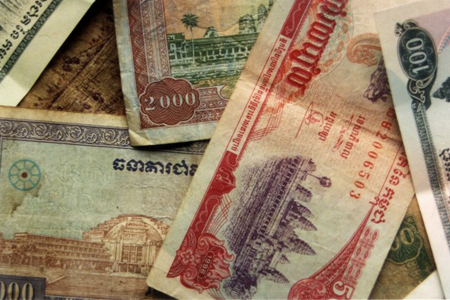Riel which has adopted as the sole official name of Cambodia’s currency has experienced two different periods in accordance with two distinct versions throughout the history. Riel was first introduced in 1953 but until 1975, it was no longer in circulation; at that time, Cambodia did not have any monetary system. It was not until 1980 that another currency whose name was also Riel was issued in Cambodia. Despite the fact that Riel is the national currency, it has been less common than U.S. dollar in Cambodia since 1993.
Indonesia’s monetary system consists of two types: banknotes and coins. The coin includes 6 denominations 50, 100, 200, and 500 Riels, almost all of which are taken out of circulation. Banknotes come in 10 denominations of 50, 100, 500, 1,000, 2,000, 5,000, 10,000, 20,000, 50,000, 100,000 Riels. The description below would provide detailed information concerning all banknotes in circulation:

- 50 riel note (Dark brown and tan): Preah Vihear Temple is stamped on the obverse and a dam is stamped on the reverse.
- 100 riel note includes 2 versions which were issued in 2001 and 2015 respectively (1st: Purple, brown and green; 2nd: Orange and brown): The first version has Independence Monument (Phnom Penh) stamped on the obverse and a school stamped on the reverse. The second version has Naga (mythical snake) head, Buddha, King Father Norodom Sihanouk as a young monk stamped on the obverse and Khmer statue, Wat Preah Keo (Silver Pagoda), and Buddha stamped on the reverse.
- 500 riel note includes 2 versions which were issued in 2002 and 2014 respectively (1st: Red and purple; 2nd: Pink and gray): The first version has Angkor Wat stamped on the obverse and Kizuna bridge over the Mekong stamped on the reverse. The second version has Naga (mythical snake) head, arms, king Norodom Sihamoni stamped on the obverse and Nak Loeung bridge, Kizuna bridge over the Mekong River, monument, frieze stamped on the reverse.
- 1,000 riel note (Brown and lilac): the Southern gate at Bayon is stamped on the obverse and Angkor Wat and Field Work is tamped on the reverse.
- 2,000 riel note (Green, black and yellow): Prasat Preah Vihear is stamped on the obverse and Autonomous Port of Kampong Saom (Sihanoukville) is stamped on the reverse.
- 5,000 Riel note (Green and gray): Norodom Sihanouk is stamped on the obverse and Bridge of Kampong Kdei (Siem Reap Province) is tamped on the reverse.
- 10,000 Riel note includes 2 versions which were issued in 2001 and 2015 respectively (1st: blue; 2nd: Violet, brown and blue): The first version has Norodom Sihanouk stamped on the obverse and Royal Palace (Phnom Penh) stamped on the reverse. The second version has Naga, mythical snake; King Norodom Sihamoni stamped on the obverse and Neak Pean (entwined serpents) archeological ruins of Buddhist temple on a circular island in Preah Khan Baray, Angkor; stone statue of horses, Balaha stamped on the reverse.
- 20,000 riel note: Norodom Sihamoni is stamped on the obverse and Angkor Wat, four faces of the Bodhisattva Avalokitesvarais are tamped on the reverse.
- 50,000 riel note includes 2 versions which were issued in 2001 and 2014 respectively (1st: Violet, brown and blue; 2nd: Brown): The first version has Norodom Sihanouk stamped on the obverse and Angkor Wat stamped on the reverse. The second version has Naga (mythical snake), King Norodom Sihanouk stamped on the obverse and Korker ruins, sculpture of a baby elephant stamped on the reverse.
- 100,000 riel note: Naga (mythical snake) head, Royal Arms of Cambodia, King Norodom Sihanouk are stamped on the obverse and King Father Norodom Sihanouk, Queen Mother Norodom Monineath and King Norodom Sihamoni, stone sculpture are stamped on the reverse.
In terms of riel currency exchange rate, one dollar has equaled to 4121.25 riels (August 2016). Because U.S dollar is the most common currency in Cambodia, it is unnecessary to exchange U.S dollar for Riel prior a Cambodia shore excursion. You can use U.S dollar to pay for both small souvenirs along the street and a restaurant meal. However, if you intend to visit the countryside, remember to exchange your money for Riel as the locals usually sell goods for riel notes. If you cannot exchange the money prior to your excursion, don’t worry as you may exchange it in many money changers in large markets in Phnom Penh such as Phsa Thmey market, Russian market, and Orusey market.
